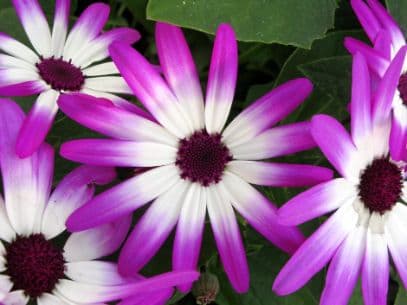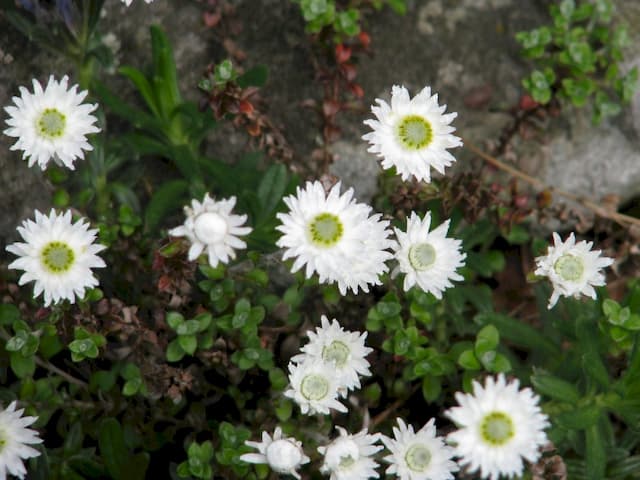Florist's Cineraria Pericallis × hybrida Senetti Magenta Bicolor = 'Sunsenereba' (PBR) (Senetti Series)

ABOUT
The Pericallis × hybrida Senetti Magenta Bicolor, commonly known as Senetti, presents a lavish display of striking magenta and white bicolored flowers. These blooms are large, showy, and daisy-like in appearance, with a distinct lush magenta edge that fades into a crisp white center. Each petal is broad and slightly overlapped, encircling a central disk that is often deep purple or yellow, adding a contrasting pop of color. The flowers are arranged in generous clusters, creating a dense and vibrant display that is visually appealing. The foliage of the Senetti plant is also noteworthy, consisting of lush green leaves that provide a lush background for the vivid floral display. The leaves are ovate to oblong, with a slightly serrated edge, and they hold a soft, somewhat velvety texture. Together, the combination of the intense magenta and white petals against the greenery makes this plant particularly eye-catching. As a whole, the Senetti exudes a bushy, mounded form that is full and well-branched, lending itself to a lush appearance in garden displays, containers, or as a standalone feature.
About this plant
 Names
NamesFamily
Asteraceae
Synonyms
Senetti, Magenta Bicolor Senetti, Florist's Cineraria
Common names
Pericallis × hybrida 'Sunsenereba'
 Toxicity
ToxicityTo humans
Senetti plants are generally not considered toxic to humans. However, as with many garden plants, it is advisable to avoid ingestion and to keep them out of reach of small children who might accidentally eat plant parts. If ingested in large quantities, mild stomach upset could occur, but this is not common. Always handle plants with care and wash hands after contact.
To pets
Senetti plants are known to be non-toxic to pets. They do not contain any known toxic substances that would harm cats, dogs, or other household pets. Nonetheless, it is always a good idea to keep plants away from pets, as eating non-food items can cause digestive upset or physical blockages. If you believe your pet has ingested a significant amount of the plant and is showing signs of distress, consult a veterinarian.
 Characteristics
CharacteristicsLife cycle
Perennials
Foliage type
Evergreen
Color of leaves
Green
Flower color
Mixed
Height
1-2 feet (30-60 cm)
Spread
1-2 feet (30-60 cm)
Plant type
Herb
Hardiness zones
9
Native area
Madeira
Benefits
 General Benefits
General Benefits- Attractive Blooms: Senetti Magenta Bicolor features striking bi-color flowers that add a splash of color to gardens and patios.
- Long Blooming Period: This variety is known for its long flowering season, providing visual interest throughout spring and early summer.
- Versatile Use: Ideal for containers, borders, and as a bedding plant, making it a flexible choice for different garden designs.
- Cool Weather Tolerant: Senetti plants thrive in cooler temperatures, extending the season of color in the garden.
- Easy to Maintain: Requires minimal maintenance, making it suitable for busy gardeners or those with limited gardening experience.
- Deadhead Encourages Blooms: Removing spent flowers encourages the plant to produce new blooms, extending the display even further.
 Medical Properties
Medical PropertiesThis plant is not used for medical purposes.
 Air-purifying Qualities
Air-purifying QualitiesThis plant is not specifically known for air purifying qualities.
 Other Uses
Other Uses- Organic Dye: The vibrant petals of the Senetti plant can be used to create organic dyes for fabric or artistic purposes.
- Photography Subject: The striking bicolor appearance makes it an excellent subject for botanical photography and garden portfolios.
- Educational Tool: Senetti plants can be used in educational settings to illustrate plant hybridization and horticultural breeding techniques.
- Crafts Decoration: The blooms can be used for decorating crafts or creating natural confetti for events.
- Theme Gardens: Utilized as a color anchor in theme gardens that focus on specific color palettes.
- Floral Art: Senetti flowers can be used in fresh or dried floral arrangements for their unique color and form.
- Garden Mulch: After senescence, these plants can contribute to compost or mulch within a garden setting.
- Cultural Festivals: Could be featured in festivals to represent the onset of spring or as a symbol of vibrant life.
- Collector’s Specimen: Plant enthusiasts may grow this variety as part of a collection showcasing diverse and unique hybrids.
- Butterfly Attraction: Senetti plants can be included in butterfly gardens to attract and nourish pollinators owing to their rich nectar.
Interesting Facts
 Feng Shui
Feng ShuiThe plant Senetti is not used in Feng Shui practice.
 Zodiac Sign Compitability
Zodiac Sign CompitabilityThe plant Senetti is not used in astrology practice.
 Plant Symbolism
Plant Symbolism- Hope and Resilience: The Senetti plant is often associated with hope and resilience due to its ability to rebloom after being cut back. This characteristic symbolizes overcoming adversity and bouncing back stronger.
- Rejuvenation and Renewal: As part of the Senetti Series, known for their long blooming period and vibrant colors, these plants symbolize rejuvenation and the renewal that comes with spring.
- Joy and Cheerfulness: The vivid magenta bicolor blooms of the Senetti Magenta Bicolor bring a burst of joy and cheerfulness to any garden, symbolizing happiness and positivity.
 Water
WaterThe Senetti plant should be watered regularly to keep the soil consistently moist but not waterlogged. Typically, watering once or twice a week should suffice, but this will depend on the climate and indoor conditions. The method involves watering the soil directly rather than the leaves to avoid fungal diseases. During active growth periods, usually in spring and summer, the plant might need closer to 16-24 ounces of water per week, while in the dormant seasons, water requirements may decrease. Always check the top inch of soil for dryness before watering to ensure the plant is not over-watered.
 Light
LightSenetti plants thrive best in bright, indirect light. Place the plant in a spot where it will receive plenty of light but is shielded from the harsh, direct midday sun, which can scorch the foliage. An east or west-facing window would be ideal, offering the right balance of light throughout the day.
 Temperature
TemperatureSenetti prefers cooler temperatures and will do well in conditions ranging between 50 and 65 degrees Fahrenheit. It is important to protect the plant from frost, as it can only tolerate temperatures down to about 35 degrees Fahrenheit. For optimal growth, maintain the nighttime temperature around 5 to 10 degrees cooler than the daytime temperature, but not dipping below the minimum threshold.
 Pruning
PruningPruning Senetti plants helps to encourage bushier growth and more abundant flowering. Deadhead spent flowers and prune back leggy stems as needed, which can be done every few weeks during the blooming period. The best time to prune extensively is in late winter or early spring before new growth begins.
 Cleaning
CleaningAs needed
 Soil
SoilSenetti plants thrive in well-draining potting soil with good organic matter content. A mix of loam, peat, and perlite is ideal. Aim for a soil pH between 5.5 and 6.5 for optimal growth.
 Repotting
RepottingSenetti, commonly known as Pericallis, should be repotted annually as they prefer fresh soil. This also allows for checking root health and upsizing if the plant has outgrown its pot.
 Humidity & Misting
Humidity & MistingSenetti plants prefer moderate to high humidity levels. Aim for about 50-60% relative humidity for the best growth conditions.
 Suitable locations
Suitable locationsIndoor
Place Senetti in bright, indirect light and avoid cold drafts.
Outdoor
Senetti like part shade and protection from harsh sun.
Hardiness zone
Senetti are typically suited for USDA zones 9-11.
 Life cycle
Life cycleThe Pericallis × hybrida Senetti Magenta Bicolor, commonly known as Senetti, begins its life cycle as a seed germinating in moist, well-draining soil under warm conditions. The germinated seedling develops into a vegetative stage, where it grows leaves and stems vigorously when provided with ample sunlight and water. As it matures, the Senetti enters the flowering stage, producing vibrant magenta and blue bicolored flowers that bloom in the spring to early summer. After pollination, the flowers will fade and the plant focuses energy on producing seeds for the next generation. If the conditions are not favorable for seeding, or gardeners deadhead spent flowers, the plant may undergo a rest period before entering a second bloom cycle later in the growing season. The Senetti is often treated as an annual or biennial, though in suitable climates and with proper care, it can survive as a perennial, repeating its life cycle for several years.
 Propogation
PropogationPropogation time
Spring
Propogation: The most popular method of propagating Pericallis × hybrida Senetti Magenta Bicolor, commonly known as Senetti, typically involves taking cuttings. This can be done in late summer to fall when the plant is actively growing. A healthy, non-flowering stem is selected, and a cutting approximately 2 to 4 inches (5 to 10 cm) long is taken, making sure that it includes at least a couple of leaf nodes. The lower leaves are removed, and the cut end is often dipped in rooting hormone to encourage root development. The cutting is then inserted into a moist, well-draining potting mix. Providing a warm environment and maintaining high humidity around the cutting can be achieved by covering it with a plastic bag or placing it in a propagator. Roots typically start to form within a few weeks, after which the new plant can be gradually acclimatized to normal conditions before potting on.

![Dahlia [American Pie]](/_next/image?url=https%3A%2F%2Fplants-admin.emdemapps.com%2Fimages%2Fplants%2F%2Fimages%2F604b646522398.png&w=640&q=75)







